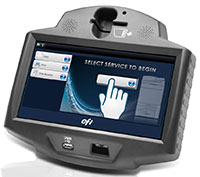University Center of Lake County Solves Print Management Headaches with Self-Serve Stations

The EFI M500 |
University Center of Lake County
(UCLC), a satellite campus facility serving 19 colleges and universities in
Illinois, has made it easier for students, faculty and corporate visitors to
access copy and print services, while reducing administrative overhead for its
staff.
Take this Fob and Shove It
Public and private colleges and universities from around the state use the
center to offer bachelor completion, graduate and advanced professional
development programs to students in the Lake County area. The facility provides
approximately 24 classrooms, large and small, including a few computer labs and
videoconference-enabled rooms, as well as a conference center, auditorium and
executive meeting room.
When Joe Kane, director of technology and business development at UCLC, took
on his role at UCLC five years ago, one of the first things people said to him
was, "You've got to do something about the printing!"
At the time, students had to purchase a key fob; they could put money onto it
and then use the fob at the center's copy and print machines. According to Kane,
the method was administratively intense because staff had to take payments and
apply them to the fobs, and people tended to forget their fobs because they were
awkward to carry, leaving them unable to copy or print documents.
Card Act to Follow
In early 2013, UCLC decided it was time to find a better solution for
printing. Kane's primary criterion was that he didn't want to have to
authenticate anybody, "so anybody could walk in off the street, print or copy,
pay their way and not be bothered by us," he said.
According to Kane, UCLC serves three main groups of people: students, faculty
and corporate visitors, and he wanted all three to have equal access to the
center's machines for copying and printing. The different types of users
have different needs and expectations: For example, students expect to be able
to pay using a credit or debit card, but faculty needed a way to copy or print
that could either be prepaid by or invoiced to their university.
After talking to numerous vendors, the UCLC selected the
M500 Self-Serve Copy and
Print Station from EFI. "We looked at the
hardware and software, the cost and the support, and pretty much every step of
the way it fit reasonably well," said Kane.
The M500 connects to UCLC's copy and print machines. It lets users pay for
copies using their credit or debit card, or in the case of faculty, an
authorized cash card. They can print from networked computers at the center, as
well as from USB drives, mobile devices or cloud accounts such as Dropbox,
Google Drive and PrintMe. The M500's touchscreen also lets users preview their
files before printing.
Making It Work
UCLC implemented three of the M500 Self-Serve Copy and Print Stations. The
center is small with limited staff, so in preparation for the installation Kane
enlisted the assistance of his network consultant. "We determined there was very
little risk to our network environment," said Kane. The devices are directly
attached to and communicate with the copiers and printers, but they can't access
the network, and the administrative software is installed within UCLC's
administrative network, so it also presented low risk.
For the installation itself, UCLC partnered with a small, local organization
that handles the center's print and copy maintenance, "so when we need support
going forward, they might be in a better position to help us than the big guys
we talked to," said Kane. The arrangement was mutually beneficial because it
gave the local organization experience installing the M500 system.
According to Kane, the implementation process was relatively straightforward
and the system was ready to go in time for the start of the fall 2013 semester.
For students and visitors to UCLC, using the M500 is pretty much the same as
copying or printing at Kinko's or any other commercial copy center. They insert
their credit or debit card, select their copy and print options and press a
button. However, for faculty teaching satellite courses at the center, the
process isn't quite as simple.
Because faculty at UCLC are visiting from other colleges and universities,
they need a way to pay for printing at the center, but they can't be expected to
pay with their own credit or debit card. To solve that problem, UCLC uses
refillable cash cards from EFI. UCLC's member universities can load the cards
with funds, and then faculty members can sign out their university's card from
UCLC's receptionist when they need to copy or print. When the available funds on
the card get low, UCLC informs the university so they can top it up again. "It
creates a little bit of an administrative headache," said Kane, "but it's pretty
simple." For other universities that simply let their faculty members run up a
tab, UCLC uses EFI's administrative software to report on transactions and
generate invoices.
Prints Charming
In the year since implementing the M500, the administrative staff at UCLC
have saved hours of work every month and the complaints about printing have all
but disappeared. "I can count on one hand the number of times folks from our
organization have complained about the system," said Kane. "In the past I would
hear something every week."
The new system has made copying and printing simpler for UCLC's visitors,
too. Kane gave the example of a corporate client who was visiting from Germany. He was
boarding a flight home that afternoon and needed to print his boarding pass.
Kane asked him if he had a cloud storage account, such as Dropbox or Google
Drive. He did. "Put it there," said Kane, "and bingo, you print it here."
"People are very pleased with that," said Kane. "It seems very modern, so to
speak, and convenient."